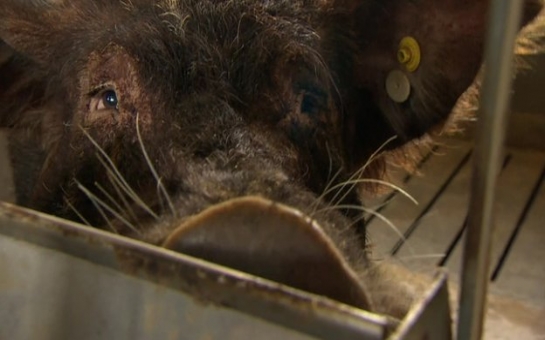By Rupert Wingfield-Hayes
BBC News
I am standing in a fully functioning operating theatre. A surgeon and team of specialists in green smocks are preparing to operate. But I'm not in a hospital. I am on a farm deep in the Japanese countryside. On the gurney about to undergo the knife is a six-month-old female pig.
Standing over her, scalpel in hand, is Professor Nagashima. He carefully cuts open her abdomen and pulls out her uterus. To me, it looks more like intestines - but he assures me this is what a pig's uterus looks like. Then with a syringe and a catheter, he begins to inject 40 embryos into the uterus.
The unconscious pig is about to become a surrogate mother - and the embryos she is now carrying are very special. They are chimeric, that is, they carry genetic material from two different species.
In a nearby shed Prof Nagashima takes me to see his most prized possessions. For this I have to change into full smock, hat, boots and mask. It is not to protect me, it is to protect the occupants - fully grown chimeric pigs.
Halfway down the long white shed, I am introduced to pig number 29 - a large, hairy male with jutting tusks. Number 29 is a white pig, but he is covered in coarse, black hair. More importantly, inside, he has the pancreas of a black pig.
How is that possible? It starts off by making what Prof Nagashima calls "a-pancreatic" embryos. Inside the white pig embryo, the gene that carries the instructions for developing the animal's pancreas has been "switched off".
The Japanese team then introduce stem cells from a black pig into the embryo. What they have discovered is that as the pig develops, it will be normal except for its pancreas, which will be genetically a black pig's.
But this is just the first step.
In a lab at Tokyo University Professor Hiro Nakauchi is taking the next one, and this is even more astonishing.
Prof Nakauchi takes skin cells from an adult brown rat. He then uses gene manipulation to change these adult skin cells into what are called "iPS" cells. The amazing thing about induced pluripotent stem cells is that they have many of the same characteristics as embryonic stem cells. In other words, they can develop into any part of the animal's body.
IPS cells were first created in 2006 by Japanese medical researcher Dr Shinya Yamanaka. In 2012, he won the Nobel Prize for his discovery.
In his lab, Prof Nakauchi has succeeded in using these iPS cells to grow a brown rat pancreas inside a white mouse.
So why is all of this so important?
The ultimate objective of this research is to get human organs to grow inside pigs. By itself, that would be a massive breakthrough for science. But what Prof Nakauchi is trying to achieve goes further. He is hoping to develop a technique to take skin cells from a human adult and change them in to iPS cells. Those iPS cells can then be injected into a pig embryo.
The result, he hopes, will be a pig with a human pancreas or kidney or liver, or maybe even a human heart. Not only that, the organ would be genetically identical to the human from which the skin cells were taken.
This is one of the holy grails of medical research: the ability to reproduce a human organ that is genetically identical to the person who needs it. It could mean an end to donor waiting lists, and an end to problems of organ rejection.
But there are many potential obstacles ahead. The first is that pigs and humans are only distantly related. It is one thing to get a black pig pancreas to grow inside a white pig, quite another to get a human pancreas to do the same. Prof Nakauchi is confident it can be done. He thinks it will take at least five years, but admits it could take much longer.
The other problem is getting approval. In Japan, it is illegal to make human-animal hybrids. Prof Nakauchi is pushing for a change in the law. But if that does not happen, he may have to move his research to America.
There are many here in Japan who oppose the idea of human-animal hybrids. Animal rights activists object to the idea of pigs, sheep or goats being used as human organ factories. Many more feel uncomfortable about the idea of pig-human hybrids. It brings to mind HG Wells' sci-fi classic, The Island of Dr Moreau.
Prof Nakauchi said his research is completely different. The pigs would still be pigs; they would just be carrying some human tissue inside them. He said there has always been resistance to new scientific breakthroughs. He points to widespread objections to In Vitro Fertilisation (IVF) when it was invented in Britain the 1970s. Today, IVF is used across the world, and no one thinks it is strange or unethical.
Whatever the ethical debate, for the hundreds of thousands of people around the world waiting for a new kidney or liver, the prospect of being able to make one to order is an astonishing thought.
ANN.Az











